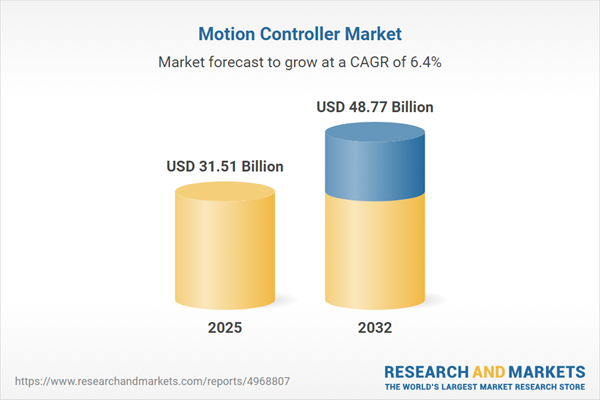Speak directly to the analyst to clarify any post sales queries you may have.
As senior leaders seek to advance industrial automation, motion controllers have emerged as a pivotal technology for enhancing operational agility and enabling seamless digital transformation. Adapting to evolving industry requirements, organizations are leveraging advanced control solutions that help streamline processes and support strategic modernization.
Market Snapshot: Motion Controller Market Size and Growth
The motion controller market is characterized by robust growth, fueled by accelerated industrial automation and a growing demand for accurate, high-precision control. Organizations are investing proactively to integrate advanced automation solutions while retaining legacy infrastructure, optimizing modernization timelines and reducing replacement risks. This momentum is particularly strong within robotics, packaging, and discrete manufacturing, where reliable and precise control technology is essential for meeting production targets and enhancing flexibility. As businesses deepen integration of motion controllers, their value is shifting from basic automation support toward enabling dynamic responses to changing operational and market needs.
Scope & Segmentation of the Motion Controller Market
The report provides senior decision-makers with a comprehensive view of motion controller deployment, giving clarity on actionable strategies for greater efficiency and resilience. Coverage includes segment-level dynamics, technology adoption, and regional market influences that drive procurement and investment choices.
- Product Types: Integrated controllers deliver real-time management for both motion and drive functions, enhancing productivity across machine workflows. PC-based controllers offer flexible and scalable architectures to support evolving production requirements. Standalone controllers facilitate phased modernization, preserving support for established equipment and extending operational lifespans.
- Applications: Motion controllers in CNC machining deliver the precision necessary for high-quality milling and grinding outputs. Robotics, including SCARA, articulated, delta, and collaborative variants, depend on refined motion control to maintain safe, efficient operation. Packaging processes, such as labeling and capping, are streamlined through automation to drive throughput and consistency.
- End User Industries: Automotive manufacturers benefit from improved coordination and efficiency in assembly processes. Electronics and semiconductor sectors utilize controller-based workflows for compliance and high-quality output. Further adoption in industries such as food and beverage, healthcare, pharmaceuticals, energy, and utilities supports sector-specific goals like safety and uptime optimization.
- Regions: The Americas, EMEA, and Asia-Pacific each navigate distinct regulatory conditions and industry standards. Key markets in China, India, Japan, Australia, and South Korea influence procurement strategies and compliance measures due to region-specific regulations and market trends.
- Key Vendors: Companies including Honeywell International Inc., Mitsubishi Electric Corporation, Omron Electronics LLC, and Siemens AG offer specialized motion control portfolios designed to address regulatory and operational requirements across diverse sectors worldwide.
Key Takeaways for Senior Decision-Makers
- Phased adoption of motion controllers mitigates technological and operational risk, supporting continuous modernization while minimizing disruptions to existing assets.
- Integration of real-time analytics and edge computing provides agility, enabling rapid adjustments in production and reinforcing operational quality and reliability.
- Modular hardware and open communication standards facilitate straightforward upgrades, ensuring smooth transitions to new automation platforms and standards.
- Enhanced cybersecurity is crucial as interconnected systems grow more complex, safeguarding industrial operations and meeting compliance obligations.
- Utilization of artificial intelligence and digital twin solutions supports predictive maintenance, increasing asset reliability and optimizing operational resources.
- Strong technical support frameworks align with long-term business goals, underpinning agility and confidence as production demands change.
Tariff Impact and Strategic Responses
Shifts in US tariff policy are affecting cost structures for motion controller components, prompting senior executives to broaden their supply base to markets in Southeast Asia and Eastern Europe. Nearshoring is being explored to ensure supply continuity. Updated procurement approaches now emphasize building resilient supplier relationships, selecting compliant alternative materials, and employing flexible inventory strategies to sustain production during regulatory shifts.
Methodology & Data Sources
Analysis is based on structured interviews with senior industry stakeholders and input from motion controller suppliers. Insights are validated using technical registries, regulatory documents, and scenario analysis, ensuring recommendations align with established best practices in industrial automation assessment.
Why This Report Matters
- Helps leadership align motion controller investments with long-term digital transformation objectives and evolving competitive strategies.
- Supports adaptation to regional compliance requirements and procurement best practices, reinforcing operational resilience through regulatory shifts.
- Prepares executive teams to navigate upcoming technology and standards changes, promoting flexibility across diverse industrial settings.
Conclusion
Motion controllers are integral to driving operational upgrades and advancing industrial automation initiatives. This report provides actionable strategic guidance to future-proof investments and enhance industrial competitiveness.
Additional Product Information:
- Purchase of this report includes 1 year online access with quarterly updates.
- This report can be updated on request. Please contact our Customer Experience team using the Ask a Question widget on our website.
Table of Contents
3. Executive Summary
4. Market Overview
7. Cumulative Impact of Artificial Intelligence 2025
Companies Mentioned
The companies profiled in this Motion Controller market report include:- Honeywell International Inc.
- Kollmorgen Corporation
- Mitsubishi Electric Corporation
- NXP Semiconductors N.V.
- Omron Electronics LLC
- Panasonic Corporation
- Parker Hannifin Corporation
- Rockwell Automation Inc
- Schneider Electric SE
- Siemens AG
Table Information
| Report Attribute | Details |
|---|---|
| No. of Pages | 188 |
| Published | October 2025 |
| Forecast Period | 2025 - 2032 |
| Estimated Market Value ( USD | $ 31.51 Billion |
| Forecasted Market Value ( USD | $ 48.77 Billion |
| Compound Annual Growth Rate | 6.4% |
| Regions Covered | Global |
| No. of Companies Mentioned | 11 |









